Security printing
Security printing is the field of the printing industry that deals with the printing of items such as banknotes, cheques, passports, tamper-evident labels, security tapes, product authentication, stock certificates, postage stamps and identity cards. The main goal of security printing is to prevent forgery, tampering, or counterfeiting. More recently many of the techniques used to protect these high-value documents have become more available to commercial printers, whether they are using the more traditional offset and flexographic presses or the newer digital platforms. Businesses are protecting their lesser-value documents such as transcripts, coupons and prescription pads by incorporating some of the features listed below to ensure that they cannot be forged or that alteration of the data cannot occur undetected.

A number of technical methods are used in the security printing industry. Security printing is most often done on security paper, but it can also occur on plastic materials.
Special substrate
The substrate of most banknotes is made of paper, almost always from cotton fibres for strength and durability; in some cases linen or speciality coloured or forensic fibres are added to give the paper added individuality and protect against counterfeiting. Some countries, including Canada, Nigeria, Romania, Mexico, Hong Kong, New Zealand, Israel, Singapore, Malaysia, United Kingdom and Australia, produce polymer (plastic) banknotes, to improve longevity and to make counterfeiting more difficult. They may include transparent windows (up to 10 millimeters in diameter) as a security feature in areas which are not covered by the opacifying layer. Paper substrate may also include windows based on laser-cut holes covered by a security foil with holographic elements. All of this makes it difficult to reproduce using common counterfeiting techniques.
- Transparent Windows
 Recto of 1 Romanian Leu banknote (series 2005) with partially overprinted window on the left (polymer substrate)
Recto of 1 Romanian Leu banknote (series 2005) with partially overprinted window on the left (polymer substrate)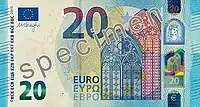 Recto of 20 euro banknote (series ES2) with holographic foil over the window (upper right side) (paper substrate)
Recto of 20 euro banknote (series ES2) with holographic foil over the window (upper right side) (paper substrate) Verso of 20 euro banknote (series ES2) with holographic foil over the window (upper left side)
Verso of 20 euro banknote (series ES2) with holographic foil over the window (upper left side)
Watermarks
True watermarks
A true watermark is a recognizable image or pattern in paper that appears lighter or darker than surrounding paper when viewed with a light from behind the paper, due to paper density variations. A watermark is made by impressing a water coated metal stamp or dandy roll onto the paper during manufacturing. Watermarks were first introduced in Bologna, Italy in 1282; as well as their use in security printing, they have also been used by paper makers to identify their product. For proofing the authenticity, the thinner part of the watermark will shine brighter with a light source in the background and darker with a dark background. The watermark is a proven anti-counterfeit technology because most counterfeits only simulate its appearance by using a printing pattern.
- Watermarks in Paper Substrate
 Watermark in a postage stamp from Zululand (around 1900)
Watermark in a postage stamp from Zululand (around 1900) Watermark in a 100 Deutsche Mark (series BBk-IIIa) from Deutsche Bundesbank
Watermark in a 100 Deutsche Mark (series BBk-IIIa) from Deutsche Bundesbank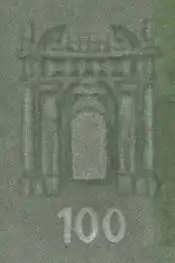 Watermark in a 100 euro (series ES1) from European Central Bank
Watermark in a 100 euro (series ES1) from European Central Bank Watermark in a 5 euro (series ES2) from European Central Bank
Watermark in a 5 euro (series ES2) from European Central Bank
Simulated watermarks
Printed with white ink, simulated watermarks have a different reflectance than the base paper and can be seen at an angle. Because the ink is white, it cannot be photocopied or scanned.[1] A similar effect can be achieved by iriodin varnish which creates reflections under certain viewing angles only and is transparent otherwise.
Watermarks are sometimes simulated on polymer currency by printing an according pattern, but with little anti-counterfeiting effect. For example, the Australian dollar has its coat of arms watermarked on all its plastic bills. A Diffractive Optical Element (DOE) within the transparent window can create a comparable effect but requires a laser beam for its verification.
Intaglio printing
Intaglio is a printing technique in which the image is incised into a surface. Normally, copper or zinc plates are used, and the incisions are created by etching or engraving the image, but one may also use mezzotint. In printing, the surface is covered in ink, and then rubbed vigorously with tarlatan cloth or newspaper to remove the ink from the surface, leaving it in the incisions. A damp piece of paper is placed on top, and the plate and paper are run through a printing press that, through pressure, transfers the ink to the paper.
The very sharp printing obtained from the intaglio process is hard to imitate by other means. Intaglio also allows for the creation of latent images which are only visible when the document is viewed at a very shallow angle.
Geometric lathe work
A guilloché is an ornamental pattern formed of two or more curved bands that interlace to repeat a circular design. They are made with a geometric lathe.

Microprinting
This involves the use of extremely small text, and is most often used on currency and bank checks. The text is generally small enough to be indiscernible to the naked eye. Cheques, for example, use microprint as the signature line.
- Enlarged microprinting
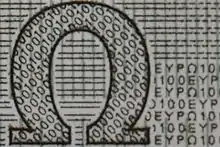 Recto of 100 euro (series ES1) (lower left)
Recto of 100 euro (series ES1) (lower left) Recto of 20 Swiss franc (8th series)
Recto of 20 Swiss franc (8th series) Recto of 1 US dollar with microprinting and guilloché in the pyramid
Recto of 1 US dollar with microprinting and guilloché in the pyramid
Optically variable ink
Optically Variable Ink (OVI) displays different colors depending on the angle at which it is viewed. It uses mica-based glitter.[2]
Colored magnetizable inks are prepared by including chromatic pigments of high color strength. The magnetic pigments’ strong inherent color generally reduces the spectrum of achievable shades. Generally, pigments should be used at high concentrations to ensure that sufficient magnetizable material is applied even in thin offset coats. Some magnetic pigment are best suited for colored magnetizable inks due to their lower blackness.
Homogeneous magnetization (no preferred orientation) is easily obtained on pigment made of spherical particles. Best results are achieved when remanence and coercive field strength are very low and the saturating magnetization is high.
When pearlescent pigments are viewed at different angles the angle of the light as it's perceived makes the color appear to change as the magnetic fields within the particles shift direction.
- Optically variable ink
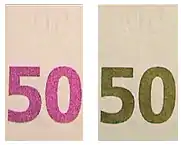 OVI of 50 euro (series ES1)
OVI of 50 euro (series ES1) Emerald number of 5 euro (series ES2)
Emerald number of 5 euro (series ES2)
Holograms
A hologram may be embedded either via hot-stamping foil, wherein an extremely thin layer of only a few micrometers of depth is bonded into the paper or a plastic substrate by means of a hot-melt adhesive (called a size coat) and heat from a metal die, or it may be directly embossed as holographic paper, or onto the laminate of a card itself. When incorporated with a custom design pattern or logo, hologram hot stamping foils become security foils that protect credit cards, passports, bank notes and value documents from counterfeiting. Holograms help in curtailing forging, and duplication of products hence are very essential for security purposes. Once stamped on a product, they cannot be removed or forged, enhancing the product at the same time. Also from a security perspective, if stamped, a hologram is a superior security device as it is virtually impossible to remove from its substrate.
- Foils with holograms
 Hologram on a 50 euro (series ES1)
Hologram on a 50 euro (series ES1) Hologram on a 100 euro (series ES1)
Hologram on a 100 euro (series ES1)
Security threads
Metal threads and foils, from simple iridescent features to foil color copying to foils with additional optically variable effects are often used.
There are two kinds of security threads. One is a thin aluminum coated and partly de-metallized polyester film thread with microprinting which is embedded in the security paper as banknote or passport paper. The other kind of security thread is the single or multicolor sewing thread made from cotton or synthetic fibers, mostly UV fluorescent, for the bookbinding of passport booklets. In recent designs the security thread was enhanced with other security features such as holograms or three-dimensional effects when tilted.
On occasion, the banknote designers succumb to the Titanic effect (excess belief in the latest technology), and place too much faith in some particular trick. An example is the forgery of British banknotes in the 1990s. British banknotes in the 1990s featured a "windowed" metal strip through the paper about 1 mm wide that comes to the paper surface every 8 mm. When examined in reflected light, it appears to have a dotted metallic line running across it, but when viewed through transmitted light, the metal strip is dark and solid.
Duplicating this was thought to be difficult, but a criminal gang was able to reproduce it quickly. They used a cheap hot-stamping process to lay down a metal strip on the surface of the paper, then printed a pattern of solid bars over it using white ink to leave the expected metal pattern visible. At their trial, they were found to have forged tens of millions of pounds’ worth of notes over a period of years.[3]
- Security threads
 Security thread of 100 euro (series ES1) (only visible in transmitted light)
Security thread of 100 euro (series ES1) (only visible in transmitted light) Security thread of 100 US dollar (series 2009) with the 3D security ribbon
Security thread of 100 US dollar (series 2009) with the 3D security ribbon Details of 3D security ribbon on 100 US dollar
Details of 3D security ribbon on 100 US dollar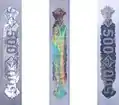 Security thread of 500 Russian ruble (series 2010) with hologram
Security thread of 500 Russian ruble (series 2010) with hologram
Magnetic ink
Because of the speed with which they can be read by computer systems, magnetic ink character recognition is used extensively in banking, primarily for personal checks. The ink used in magnetic ink character recognition (MICR) technology is also used to greatly reduce errors in automated (or computerized) reading. The pigment is dispersed in a binder system (resin, solvent) or a wax compound and applied either by pressing or by hot melt to a carrier film (usually polyethylene).[4]
Some people believe that the magnetic ink was intended as a fraud prevention concept, yet the original intent was to have a non-optical technology so that writing on the cheque, like signatures, would not interfere with reading. The main magnetic fonts (E13-B and CMC7) are downloadable for a small fee and in addition magnetic toner is available for many printers. Some higher resolution toners have sufficient magnetic properties for magnetic reading to be successful without special toner.
Serial numbers
Serial numbers help make legitimate documents easier to track and audit. To help detect forgeries serial numbers will normally have a check digit to verify the serial number. In banknote printing the unique serial number provides effective means for the monitoring and verification of the production volume.
Another method of protection is to create trap numbers within the serial number range. For example, the system may automatically invalidate numbers which are in a range of 200-300 (e.g. 210, 205 would be invalid). The system may even take single random numbers within a block (e.g. ending in 51, 37, 48 within a 200-300 range would be invalid).
- Serial numbers of banknotes
 US dollar (series 2003) with green serial number
US dollar (series 2003) with green serial number_front.jpg.webp) Russian ruble (series 2006) with variable font size (right)
Russian ruble (series 2006) with variable font size (right) 200 Guatemalan quetzal with lasered serial number (in the white area)
200 Guatemalan quetzal with lasered serial number (in the white area)
Anti-copying marks
In the late twentieth century advances in computer and photocopy technology made it possible for people without sophisticated training to easily copy currency. In an attempt to prevent this, banks have sought to add filtering features to the software and hardware available to the public that senses features of currency, and then locks out the reproduction of any material with these marks. One known example of such a system is the EURion constellation.
- Banknotes with anti-copying marks
 Recto (cutout) of 5 euro (series ES2)
Recto (cutout) of 5 euro (series ES2) Recto (cutout) of 20 US dollar (as part of the value numeral 20)
Recto (cutout) of 20 US dollar (as part of the value numeral 20) Recto (cutout) of 50,000 Korean won
Recto (cutout) of 50,000 Korean won
Copy-evident
Sometimes only the original document has value. An original signed cheque for example has value but a photocopy of it does not. An original prescription script can be filled but a photocopy of it should not be. Copy-evident technologies provide security to hard copy documents by helping distinguish between the original document and the copy.
The most common technology to help differentiate originals from copies is the void pantograph. Void pantographs are essentially invisible to the untrained, naked eye on an original but when scanned or copied the layout of lines, dots and dashes will reveal a word (frequently VOID and hence the name) or symbol that clearly allows the copy to be identified. This technology is available on both traditional presses (offset and flexographic) and on the newer digital platforms. The advantage of a digital press is that in a single pass through the printer a void pantograph with all the variable data can be printed on plain paper.
Copy-evident paper, sometimes marketed as ‘security paper’, is pre-printed void pantograph paper that was usually produced on an offset or flexographic press. The quality of the void pantograph is usually quite good because it was produced on a press with a very high resolution, and, when only a small number of originals are to be printed, it can be a cost-effective solution; however, the advent of the digital printer has rapidly eroded this benefit.
A second technology which complements and enhances the effectiveness of the void pantograph is the Verification Grid. This technology is visible on the original, usually as fine lines or symbols but when photocopied these lines and images disappear; the inverse reaction of the void pantograph. The most common examples of this technology are on the fine lines at the edge of a cheque which will disappear when copied or on a coupon when a symbol, such as a shopping cart, disappears when an unauthorized copy is made. Verification Grid is available for either traditional or digital presses.
Together the void pantograph and the Verification Grid complement each other because the reactions to copying are inverse, resulting in a higher degree of assurance that a hard copy document is an original.
Prismatic coloration
The use of color can greatly assist the prevention of forgeries. By including a color on a document a color photocopier must be used in the attempt to make a copy however the use of these machines also tends to enhance the effectiveness of other technologies such as Void Pantographs and Verification Grids (see Copy-evident above).
By using two or more colors in the background and blending them together a prismatic effect can be created. This can be done on either a traditional or a digital press. When a document using this technique is attempted to be photocopied the scanning and re-creation by a color copier is inexact usually resulting in banding or blotching and thereby immediate recognition of the document as being a copy.
A frequent example of prismatic coloring is on checks where it is combined with other techniques such as the Void Pantograph to increase the difficulty of successful counterfeiting.[5]
Halo
Carefully created images can be hidden in the background or in a picture on a document. These images cannot be seen without the help of an inexpensive lens of a specific line screening. When placed over the location of the image and rotated the image becomes visible. If the document is photocopied the Halo image is lost. A known implementation is Scrambled Indicia.[6]
Halo can be printed on traditional or digital presses. The advantage of traditional presses is that multiple images can be overlaid in the same location and become visible in turn as the lens is rotated.
Halo is used as a technique to authenticate the originality of the document and may be used to verify critical information within the document. For example, the value of a coupon might be encoded as a Halo image that could be verified at the time of redemption or similarly the seat number on a sporting event ticket.
False-positive testing
False-positive testing derives its name because the testing requires both a false and a positive reaction to authenticate a document. The most common instance is the widely available counterfeit detector marker seen in many banks and stores.
Counterfeit detector markers use a chemical interaction with the substrate, usually paper, of a document turning it a particular color. Usually a marker turns newsprint black and leaves currency or specially treated areas on a document clear or gold. The reaction and coloring varies depending upon the formulation. Banknotes, being a specially manufactured substrate, usually behave differently than standard newsprint or other paper and this difference is how counterfeits are detected by the markers.
False-positive testing can also be done on documents other than currencies as a means to test their authenticity. With the stroke of a marker a symbol, word or value can be revealed that will allow the user to quickly verify the document, such as a coupon. In more advanced applications the marker creates a barcode which can be scanned for verification or reference to other data within the document resulting in a higher degree of assurance of authenticity.
Photocopied documents will lack the special characteristics of the substrate so are easily detectable. False-positive testing generally is a one time test because once done the results remain visible so while useful as part of a coupon this technique is not suitable for ID badges for example.
Fluorescent and phosphorescent dyes
Fluorescent dyes react with fluorescence under ultraviolet light or other unusual lighting. These show up as words, patterns or pictures and may be visible or invisible under normal lighting. This feature is also incorporated into many banknotes and other documents - e.g. Northern Ireland NHS prescriptions show a picture of local '8th wonder' the Giant's Causeway in UV light. Some producers include multi-frequency fluorescence, such that different elements fluoresce under specific frequencies of light. Phosphorescence may accompany fluorescence and shows an after-glow when the UV light is switched off.
- Fluorescence of 50 euro banknote (series ES1)
 Recto at 350 nm
Recto at 350 nm
The foil of the kinegram (bottom right) and colored fibres show up Verso at 350 nm
Verso at 350 nm
The colored fibres are clearly visible
Registration of features on both sides
Banknotes are typically printed with fine alignment (so-called see-through registration window) between the offset printing on each side of the note. This allows the note to be examined for this feature, and provides opportunities to unambiguously align other features of the note with the printing. Again, this is difficult to imitate accurately enough in most print shops.
- See-through registration
 Registration pattern of 100 euro (series ES1) (recto)
Registration pattern of 100 euro (series ES1) (recto) Registration pattern of 100 euro (series ES1) (verso)
Registration pattern of 100 euro (series ES1) (verso) Registration pattern of 100 euro (series ES1) (transmission)
Registration pattern of 100 euro (series ES1) (transmission) Registration pattern of 50 Swiss franc (8th series) (transmission)
Registration pattern of 50 Swiss franc (8th series) (transmission)
Electronic devices
With the advent of Radio Frequency Identification (RFID) which is based on smart card technology, it is possible to insert extremely small RF-active devices into the printed product to enhance document security. This is most apparent in modern biometric passports, where an RFID chip mirrors the printed information. Biometric passports additionally include data for the verification of an individual's fingerprint or face recognition at automated border control gates.
Thermochromatic ink
Security ink with a normal "trigger" temperature of 88 °F (31 °C), which will either disappear or change colors when the ink is rubbed, usually by the fingertips.
Latent images
Pressure-sensitive or hot stamped labels characterized with a normal (gray or colored) appearance. When viewed via a special filter (such as a polarizer) an additional, normally latent, image appears. With intaglio printing, a similar effect may be achieved for viewing the banknote from a slanted angle.
Copy detection pattern and digital watermark
A copy detection pattern or a digital watermark can be inserted into a digital image before printing the security document. These security features are designed to be copy-sensitive[7] and authenticated with an imaging device.[8]
See also
- Authentication, particularly the subject product authentication
- Tamper-evident technology, particularly for money and stamps
- Tamper resistance, particularly the subject packaging
- Brand protection
- Security label
References
- "Security Features" (PDF). Atlanta, GA: Advantage Laser Products. p. 1. Retrieved 26 May 2014.
- "Weather Resistance Series, Pearlescent Pigment, Pearl EX Pigments". Dynasty Chemicals (NingBo) Co., Ltd. Retrieved 26 May 2014.
Pearlescent Pigments are made from mica and they are widely used in paits, coating, printing ink, plastic, cosmetic, leather, wallpaper etc.
- Security Engineering: A Guide to Building Dependable Distributed Systems (PDF). p. 245. Retrieved 26 May 2014.
banknote designers succumb to the Titanic effect
- "Magnetic pigments" (PDF). BASF, The Chemical Company. July 2004: 6. Retrieved 26 May 2014. Cite journal requires
|journal=(help) - "Security Features" (PDF). Advantage Laser Products. Retrieved 26 May 2014.
Prismatic Two-Color Pantograph A multi-color background in which two colors change density and blend into each other, making it very difficult to reproduce
- "Digital Document Security" (PDF). H.W. Sands Corp. and Graphic Security Systems Corporation. pp. 7–11. Retrieved 2019-06-15.
- Haas, B.; Dirik, A.E. (2012-11-01). "Copy detection pattern-based document protection for variable media". IET Image Processing. 6 (8): 1102–1113. doi:10.1049/iet-ipr.2012.0297. ISSN 1751-9659.
- Abele, Eberhard. (2011). Schutz vor Produktpiraterie : ein Handbuch für den Maschinen- und Anlagenbau. Ksuke, Philipp., Lang, Horst. Berlin: Springer. ISBN 978-3-642-19280-7. OCLC 726826809.
External links
- "Banknote security features" (PDF). Billetaria issue 16. Madrid: Banco de Espana. October 2014. pp. 46–47. Retrieved 2019-06-13.
It presents a catalogue of the main banknote security features recognisable by the public and currently in use worldwide.
- Security Printing Conference by Pira International
- The council of the EU: Glossary of Security Documents, Security Features and other related technical terms
- TorApp.Info Online Security Printing and Design platform
- Copy protected paper: US patent: 20100291324 A1